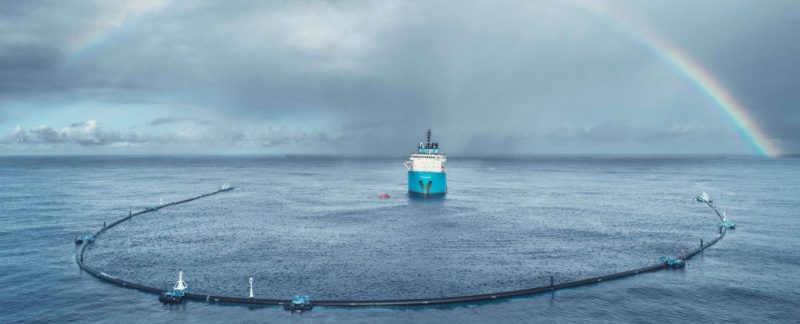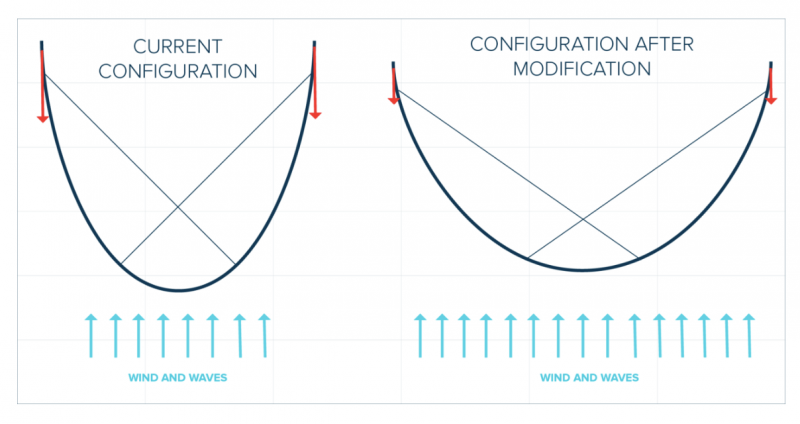
An ambitious project to clean up the Great Pacific Garbage Patch has hit an unexpected snag, just three months after being launched.
Developed by The Ocean Cleanup, the huge floating contraption was designed to drift with the currents, scooping up thousands of tons of plastic waste as it bobs along.
The first prototype, System 001, was launched in September after five years of work, bound for a bit of ocean that lies roughly halfway between Hawaii and the coast of California.
It was all very exciting. If the device lived up to its promise, in another five years, it could chomp through half the Great Pacific Garbage patch – the largest zone of ocean plastics in the world.
After less than two months of action, however, there are still some important wrinkles that need to be ironed out.
According to group leaders, the device is catching ocean plastic just fine – even the small pieces – but for some reason, it just can’t retain any of it. Apart from a few tons of discarded nets, most plastic has slipped out of the system’s grasp after a few days.
There could be various reasons why plastic is not staying inside the system, but speed is one of the top culprits.
“The most-likely reason is that the system is not moving quickly enough at every occurring condition,” Lonneke Holierhoek, chief operating officer at The Ocean Cleanup, told Forbes.
“It needs to move faster than the plastic at all times so as to retain all plastic it’s caught.”
The device is supposed to work like an artificial coastline, catching plastic that is swirling in the middle of the ocean in the same way that trash drifts up on shore.
The system hinges on a 600-metre-long floater, in the shape of a U, that hovers at the surface of the water. Below is a 3-metre-deep skirt, like open arms, ready to give all our forgotten waste a hug.
This position, somewhat submerged in the current but also floating, is crucial. On the surface, the wind and the waves push the floater along more quickly than what lies beneath.
And so, as the system outraces the deeper currents, it catches all the plastic that tends to sit just below the surface.
System 001, however, is not going fast enough and it’s letting too much plastic escape. At times, the plastic beneath the waves is even moving faster than the system itself.
But the team isn’t too worried. They didn’t expect the first prototype to be perfect, and they remain confident that the device can still work. In fact, a solution is already being tested.
Engineers on the case think the first system might have simply been too small and all that is needed is more surface area.
The team suggests that if the span of skirting can be blown up by 25 percent, then the U-shaped floater can stretch 60 to 70 metres wider than before. And the bigger the sail, the faster the boat.

The world’s oceans are vast, and plastic pollution is spread across millions of square kilometres, constantly moving in all directions, at the will of the currents. To this day, over five trillion pieces of plastic currently litter our oceans.
Trying to use boats and nets to fix this immense issue would likely cost billions of dollars and take thousands of years to complete.
A device like System 001 could work much more quickly and at a fraction of the cost. Besides, if the technology can be proven, the whole thing could one day become self-sustainable, a global ocean cleanup system that pays for itself.
By recycling the plastic collected by an ambitious 60 ocean collectors, The Ocean Cleanup hopes that new products can be created and sold to keep the endeavour running.
There are still many tweaks to come, but by 2020, the team is aiming to introduce System 002.
We’ll be eagerly waiting to see if it offers a sustainable solution to this huge and complex problem.
By CARLY CASSELLA
First published by Science Alert
The 21st Century
